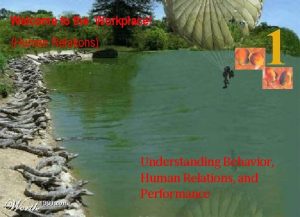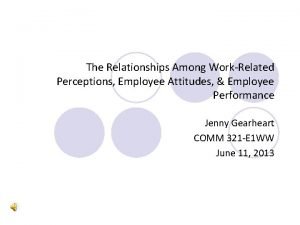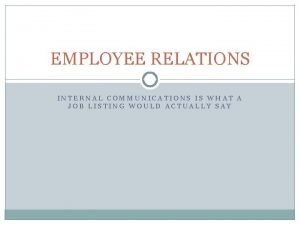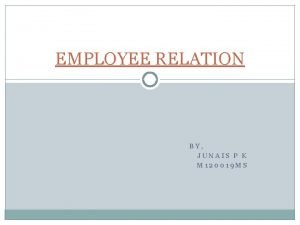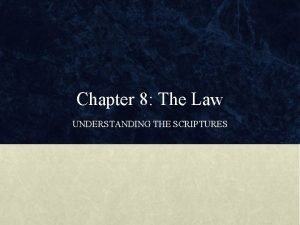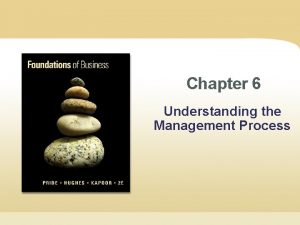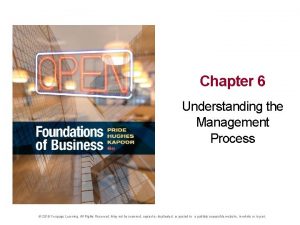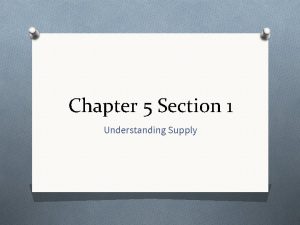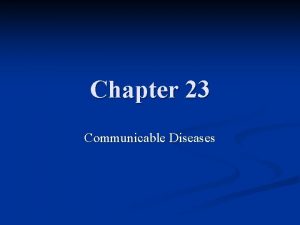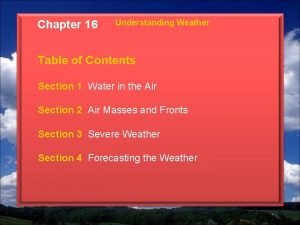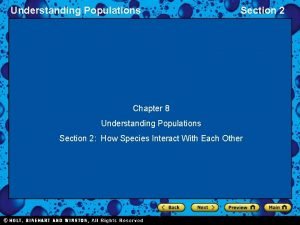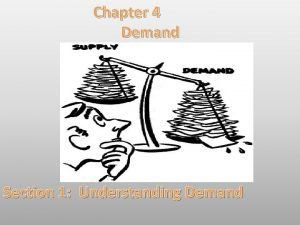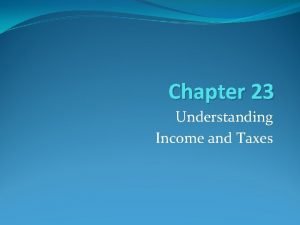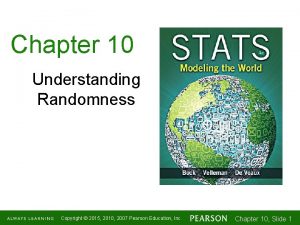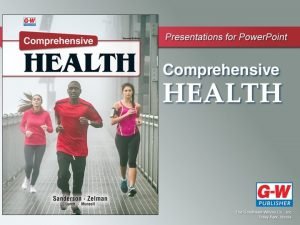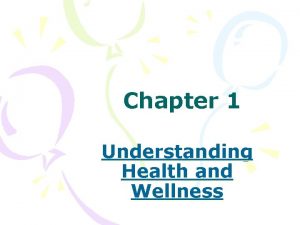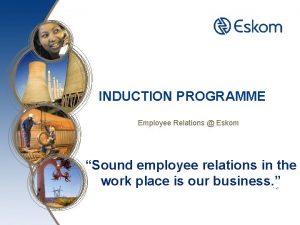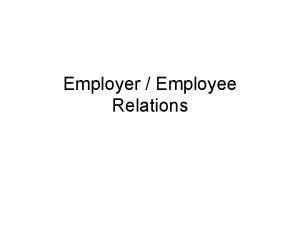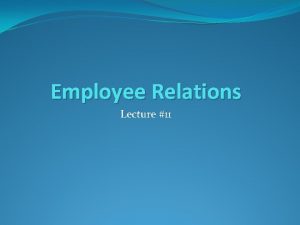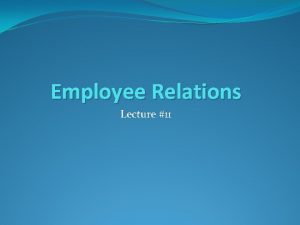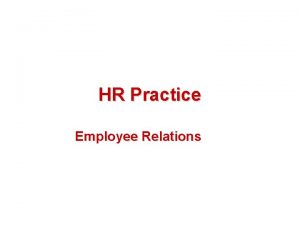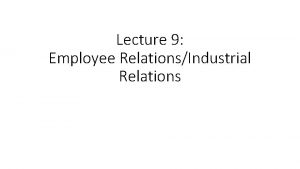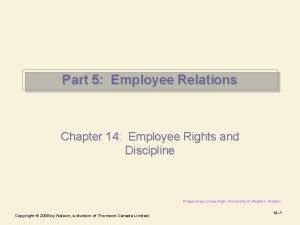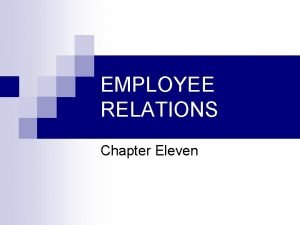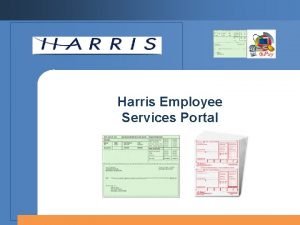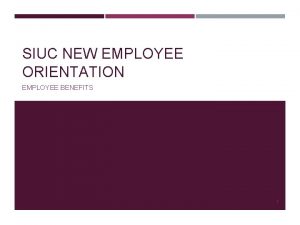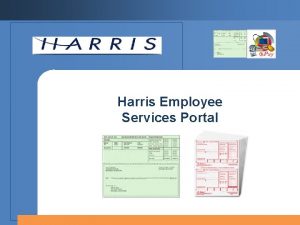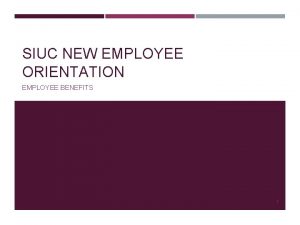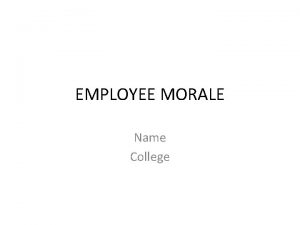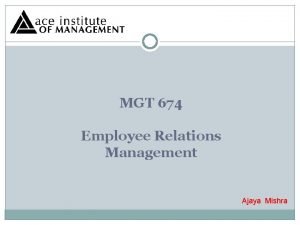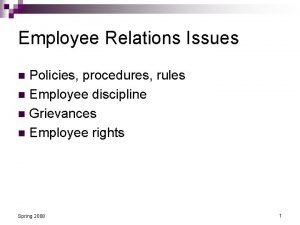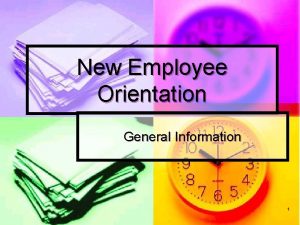CHAPTER 7 EMPLOYEE RELATIONS 1 UNDERSTANDING EMPLOYEE RELATIONS




























- Slides: 28

CHAPTER 7 EMPLOYEE RELATIONS 1

UNDERSTANDING EMPLOYEE RELATIONS • Good employee relations involve providing fair and consistent treatment to all employees • To foster good employee relations, managers must listen to and understand what employees are saying and experiencing 2

UNDERSTANDING EMPLOYEE RELATIONS • Effective employee relations require cooperation between managers and employee relations representatives • ERR will try to ensure that company policies and procedures are followed and advise both supervisors and employees on specific employee relations problems 3

TRADE UNIONS • A group of seven or more workers can form a trade union • Application for registration with DG of Trade Unions • The application form must be signed by all members • Send together with the union’s constitution • The important criterion for a union to be registered is its intended member 4

TRADE UNIONS • All workers above 16 years have the right to join an appropriate union • Workers between 16 and 21 have lesser rights to participate in union activities • Specified groups of workers are restricted from joining trade unions 5

TYPES OF UNIONS • National and regional unions • In-house unions • Employer’s associations 6

ROLE OF TRADE UNIONS • • • Protect their members’ right Will take action to stop such unfair practices Advise members on their right Encouraging government to pass legislation Introduce policies Three-pronged approach: – Individual employers – National issues – Individual members 7

COLLECTIVE BARGAINING • The process whereby employers and employees negotiate over the terms and conditions on employment • Union is required by law to gain formal recognition from the employer before any negotiation can be made 8

COLLECTIVE BARGAINING • One of the main functions of trade unions • The best method of regulating the terms and conditions of employment • Once an agreement is reached between the two parties, there will be no discrimination between them 9

COLLECTIVE BARGAINING • May be carried out between an individual employer and a trade union of employees • Or between the union of employees and the union of employers • This process is regulated by the Industrial Relation Act 10

COLLECTIVE AGREEMENTS • Written agreement between an employer and a trade union relating to terms and conditions of employment • Agreement must specify their duration, not less than three years • Must be deposited with Industrial Court • Most agreements include clauses on wages, working hours and other benefits to be given to the workers 11

INDUSTRIAL ACTION • Picket • Strike • Lockout 12

SETTLEMENT OF INDUSTRIAL DISPUTES • Conciliation • Arbitration 13

EMPLOYMENT LAWS • Employment Act • Industrial Relations Act 14

DISCIPLINE • Penalties in a disciplinary system – Oral warning – First written warning – Final written warning – Suspension without pay – Suspension of increment – Demotion or downgrading – Dismissal 15

EMPLOYEE PROBLEMS • Transfer • Promotion of employees • Grievance handling • Absenteeism of workers 16

TERMINATION OF EMPLOYEE’S CONTRACT OF EMPLOYMENT • Role of Industrial Court • Resignation • Expiry of fixed-term contract • Retirement • Redundancy and retrenchment 17

TERMINATION OF EMPLOYEE’S CONTRACT OF EMPLOYMENT • Dismissal of misconduct • Dismissal for poor performance • Frustration of contract • Termination of probationers • Constructive dismissal 18

CHAPTER 8 SAFETY AND HEALTH 19

ACCIDENTS AT WORK • Financial costs • Losses of output • Lowered morale • Negative publicity 20

TYPES OF ACCIDENTS • Near miss • Non-fatal • Fatal 21

CAUSES OF ACCIDENTS • Technical causes • Human causes • Environmental causes 22

ENSURING A SAFE WORKPLACE • Safety policies – A statement of organization’s commitment – An explanation of who’s responsible – A description of procedures • Safety programmes – Commitment from all employees – Officer in-charge of safety 23

ENSURING A SAFE WORKPLACE • Safety programmes – Record keeping – Safety training – Safety and healthy living campaigns – Incentive and reward schemes – Provision of personal protective equipment – Disciplinary system 24

OCCUPATIONAL SAFETY AND HEALTH ACT • Ensure the safety of all employees and any other person at the workplace • Draft and disseminate a safety policy • Appoint a safety committee • Appoint a dedicated, qualified safety and health officer • Provide appropriate training, supervision and information 25 • Report serious accidents to DOSH

SEXUAL HARASSMENT • An unwanted conduct of a sexual nature having the effect of verbal, non-verbal, visual, psychological or physical harassment • Not acceptable behaviour and any employee found guilty of such conduct will be punished 26

IMPROVING EMPLOYEES’ HEALTH • Wellness programmes • Stress management • Reducing problems drug and alcohol related 27

EMPLOYEE ASSISTANCE PROGRAMS • Programs designed to help employees whose job performance is suffering because of physical, mental or emotional problems • Four steps involve: – Identify troubled employee – EAP counseling – Solve the problem – Depend on the outcome of the treatment 28
 Employee relations in public relations
Employee relations in public relations Understanding human relations
Understanding human relations Employee attitudes and employee performance
Employee attitudes and employee performance Employee relations communications
Employee relations communications Employee relations importance
Employee relations importance Chapter 9 lesson 3 understanding violence
Chapter 9 lesson 3 understanding violence Understanding the scriptures chapter 24 study questions
Understanding the scriptures chapter 24 study questions Chapter 6 understanding the management process
Chapter 6 understanding the management process The process of evaluating and regulating ongoing activities
The process of evaluating and regulating ongoing activities Section 1 understanding supply
Section 1 understanding supply Chapter 23 lesson 2 common communicable diseases
Chapter 23 lesson 2 common communicable diseases Understanding the scriptures chapter 22 study questions
Understanding the scriptures chapter 22 study questions Understanding the scriptures chapter 20 study questions
Understanding the scriptures chapter 20 study questions Chapter 16 section 3 severe weather answer key
Chapter 16 section 3 severe weather answer key Chapter 8 understanding populations
Chapter 8 understanding populations Chapter 4 lesson 1 understanding stress
Chapter 4 lesson 1 understanding stress Lesson 1: understanding demand
Lesson 1: understanding demand Chapter 23 understanding income and taxes
Chapter 23 understanding income and taxes Chapter 10 understanding randomness
Chapter 10 understanding randomness The ability to locate interpret and apply information
The ability to locate interpret and apply information Chapter 1 understanding health and wellness answer key
Chapter 1 understanding health and wellness answer key Understanding your health and wellness
Understanding your health and wellness Understanding human communication 14th edition chapter 1
Understanding human communication 14th edition chapter 1 Chapter 1 understanding health and wellness lesson 4
Chapter 1 understanding health and wellness lesson 4 Chapter 1 lesson 2 what affects your health
Chapter 1 lesson 2 what affects your health Chapter 1 lesson 2 what affects your health
Chapter 1 lesson 2 what affects your health Chapter 1 understanding your health and wellness
Chapter 1 understanding your health and wellness Chapter 1 understanding your health and wellness
Chapter 1 understanding your health and wellness Chapter 1 understanding business communication
Chapter 1 understanding business communication

